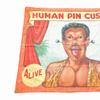Americana Week: Buyers Find Plenty of Treasures, from Folk to Fancy
- January 27, 2014 23:23
For collectors and curators looking for the unusual, the beautiful, the "best of the best," or simply a take-home slice of Americana, Antiques Week in New York offered it all.
While temperatures dipped into the teens, collectors arrived from all parts of the country for what is also called Americana Week and heated up the auction rooms and show floors with big-ticket sales in American folk and decorative arts, and other categories.
Not just one of his prized lithographs, but an orginal watercolor of ducks by John James Audubon had collectors clamoring at the Winter Antiques Show booth of The Old Print Shop.
Pre-dating the Declaration of Independence, a rediscovered document that is both a patriot's plea for peace with Great Britain and an early stand for American independence skyrocketed from a $100,000-400,000 presale estimate to fetch $912,500. It was sold by Keno Auctions to benefit The Morris- Jumel Mansion.
Santa Claus topped Sotheby's sale of folk art from the collection of now-imprisoned jeweler Ralph Esmerian. The jolly figure that Samuel A. Robb carved for his daughter, estimated at $150,000-250,000, garnered $875,000
This year’s 60th edition of the Winter Antiques Show (through Feb. 2 t the Park Avenue Armory) is feted with a loan exhibition from the Peabody Essex Museum and a spectacular diamond display, including Queen Victoria’s diamond tiara on loan from a private collection by arrangement through Wartski.
The dazzling Diamond Jubilee celebration of the show attracted some 2,000 people for the opening night on Thursday, with celebrity antiques aficionados like Martha Stewart, designers from Bunny Williams to Thomas Jayne, and museum curators including the Museum of Fine Arts, Boston’s Erica Hirshler.
American folk art had a strong representation, as always. The bold and often whimsical offerings that dealer Allan Katz so expertly seeks out went quickly. Of note, buyers picked up a carved Civil War reunion cane ($24,000), a ca.-1830 paint-decorated clock ($45,000), and a well-preserved trio of characters called “The Shaffer Family Ventriloquist and Musical Ensemble” ($45,000) who had entertained post-Civil War America.
Robert Young, who handles English folk art, had a remarkably-intact ca.-1880 set of 180 animals in a Noah’s Ark ensemble ($35,000). Children were allowed to play with these sets on Sundays when other toys were off-limits. With adult supervision of the playtime, such sets have survived, although rarely with so many animals, explained Young.
A rare cast-bronze figural lobster clock of French origin ($8,500), circa 1890, drew eyes between the tall-case clocks in the Delaney booth.
Another striking booth was formed by Lost City Arts. A George Nakashima table was accented with table sculptures by Harry Bertoia ($45,000) whose work is on the rise with serious collectors, according to the gallery’s Jim Elkind. Sparkling on a wall, Bertoia’s bronze and copper screen was priced at $295,000.
Jonathan Boos also sold a fine example by Bertoia, a ca.-1960 welded metal sculpture that took an organic form akin to coral. Bertoia’s work was once lumped with 20th-century decorative arts and furniture design, says Boos, and while museums have long sought his sculptures, private collectors are increasingly snapping them up.
(For more Bertoia, an exhibit organized by Abby M. Taylor and Graham, whose gallery is located a few blocks from the show at 32 East 67th St., has on view the artist’s sound sculptures referred to as Sonambients. The exhibit runs through Feb. 15.)
Stand-out paintings included a newly-discovered Raphaelle Peale still-life at Schwarz, a John Singer Sargent 1882 portrait “Lady in Black” ($3.5 million) from Adelson, and a Frederick Judd Waugh seascape with an Arctic iceberg and polar bear from Arader Galleries. (Read my full report on the American art offerings at the show in the March-April 2014 issue of American Fine Art Magazine.)
A ceramic Art Nouveau fireplace surround, plucked from the Parisian home of a Moulin Rouge dancer who was a favorite subject of Toulouse-Lautrec, was an exotic backdrop to the dazzling Tiffany lamps at Macklowe Gallery's booth.
Alexander Gallery had a lively display of Revolutionary War-era uniforms and portraits, including a Gainsborough depicting Admiral Philip Affleck (ca. 1780s) and a mannequin sporting the uniform worn by the first English ambassador to the U.S.
London’s Martyn Gregory showed a portrait of Philadelphia merchant William Read ($96,000), painted by Spoilum, the Chinese artist who was active ca.1770-1805. The booth also featured a spectacular suite of three paintings showing the Hongs of Canton, before, during and after the fire that destroyed them during the China Trade era.
The Metro show, the New York Ceramics Fair, and the Armory Antique Show, running concurrent to the Winter Antiques Show, had plenty to entice buyers, too. At the Metro Show, held in Chelsea, California's Just Folk debuted 28 works by folk artist Bill Traylor that had been hidden away for more than 15 years.
Besides the Santa, Sotheby’s sold many top-notch examples of American folk art amassed by Esmerian. The sale nearly topped $13 million, setting a new record total for any auction of American folk art. Esmerian's creditors will get $10.5 million of the total.
A few highlights of the Esmerian sale: a rare oval sgrafitto earthenware dish fetched $281,000 (est. $40,000-60,000), Jacob Maentel’s double portrait of John Bickel and Caterina Bickel brought $401,000 (twice the low estimate), and a Shute portrait of Mary Ann Russell catapulted from a low estimate of $30,000 to $317,000 while another one soared to $665,000.
Christie's sale on Jan. 24 brought $5.4 million with the top lot taken by a Chippendale Carved Mahogany Scallop-Top Tea Table, probably the shop of Benjamin Randolph (1737-1791), with carving possibly by Richard Butts, Philadelphia, circa 1770. It fetched $905,000, a seeminlgy small sum compared to the recent numbers for modern and contemporary art, but a solid price for the "old, brown wood" with good provenance that is the backbone of Americana Week.




















